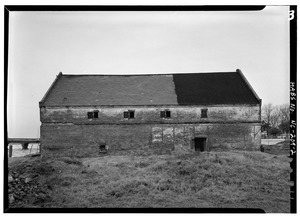Battle of Washington facts for kids
Quick facts for kids Battle of Washington, North Carolina |
|||||||
|---|---|---|---|---|---|---|---|
| Part of the American Civil War | |||||||
 Union forces attempted to set fire to Havens Warehouse (above) but it survived the war. |
|||||||
|
|||||||
| Belligerents | |||||||
| Commanders and leaders | |||||||
| John G. Foster | Daniel H. Hill | ||||||
| Units involved | |||||||
| XVIII Corps Washington Garrison |
Hill's division | ||||||
| Strength | |||||||
| 6 regiments artillery units 12,000 |
1 Division 9000 | ||||||
| Casualties and losses | |||||||
| 40 | 60 | ||||||
The Battle of Washington was a military event during the American Civil War. It happened in Beaufort County, North Carolina, from March 30 to April 19, 1863. This battle is sometimes called the Siege of Little Washington. A siege is when an army surrounds a town or fort to try and make the people inside surrender.
Contents
Why the Battle Happened
After some earlier fighting, the Confederate Army didn't pay much attention to North Carolina. But in December 1862, Union soldiers from New Bern destroyed a railroad bridge at Goldsboro, North Carolina. This bridge was very important for moving supplies.
Even though the damage was fixed quickly, it made the Confederates realize they needed to protect the coast of Virginia and North Carolina better. After a big Confederate win at Fredericksburg, General Robert E. Lee sent a large part of his army to deal with Union forces along the coast.
General James Longstreet was in charge of this force. While Longstreet fought near Suffolk, Virginia, another general, Daniel Harvey Hill, led his troops toward Union bases at New Bern and Washington, North Carolina.
Major General John G. Foster was the Union commander in charge of defending the North Carolina coast. After Hill's attack on New Bern failed, Foster went to Washington to take charge of its defense himself.
The Siege Begins
General Foster was a trained engineer, and he used his skills to make Washington's defenses stronger. He also used three gunboats to help protect the town. By March 30, the town was surrounded by forts and defenses.
Confederate General Richard B. Garnett's soldiers began to surround Washington. Meanwhile, General Hill set up cannons and blocked the Tar River to stop Union ships from bringing help. He also placed two brigades (groups of soldiers) south of Washington to stop any help coming by land from New Bern.
The Confederates sent a message to Foster, telling him to give up. Foster bravely replied, "If the Confederates want Washington, come and get it." However, Foster didn't have enough soldiers to push the Confederates away. Hill also had orders to avoid a direct attack because it would cause too many casualties (deaths or injuries).
So, the fighting turned into an artillery battle, where both sides fired cannons. The Confederates even limited their firing to save ammunition. As time went on, both sides started running low on supplies. Conditions became very difficult because of the rain and mud. Even though Hill wasn't capturing Washington, he was achieving an important goal: his soldiers were able to gather food and supplies from the area while the Union forces were stuck in the town.
Attempts to Help
Union forces tried to send help to Washington. One group, led by General Henry Prince, sailed up the Tar River. But when Prince saw the Confederate cannons, he simply turned his ships around.
Another attempt was made by General Francis B. Spinola, who marched his soldiers overland from New Bern. Spinola was defeated at Blount's Creek and had to go back to New Bern.
General Foster decided he needed to escape Washington and lead the relief effort himself. He left his chief officer, General Edward E. Potter, in charge of Washington. On April 13, a Union ship called the USS Escort bravely sailed past the Confederate cannons and made it into Washington. The Escort brought supplies and more soldiers.
On April 15, Foster escaped on the USS Escort. The ship was badly damaged, and the pilot was seriously wounded, but Foster made it out safely.
The Siege Ends
Around the same time Foster escaped, General Hill decided to end the siege. He had several reasons:
- His soldiers had finished gathering the supplies they needed.
- Union supplies had reached the soldiers inside Washington.
- He received a message from General Longstreet asking for more soldiers to help with an attack on Suffolk.
So, on April 15, Hill began to pull his soldiers away from Washington's defenses.
Meanwhile, Foster had returned to New Bern and quickly started organizing a new relief effort. He ordered General Prince to march toward Kinston to stop Confederates near Goldsboro. Foster himself led another group north from New Bern toward Blount's Creek, where General Spinola had been stopped earlier.
On April 18, Foster ordered Spinola to push the Confederates away from a roadblock at Swift Creek. This roadblock was on the direct road from Washington to New Bern. At the same time, General Henry Morris Naglee attacked the Confederate soldiers who were leaving the area near Washington. He captured several prisoners and a battle flag.
On April 19, Foster returned to Washington's defenses. By April 20, the Confederates had completely left the area.
What Happened Next
After this battle, North Carolina remained fairly quiet for a while. There were only a few small raids led by Foster and Potter. It wasn't until 1864 that General Robert E. Lee was able to send more troops to North Carolina for another operation against Union control posts along the coast.


